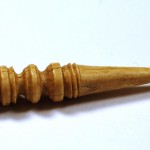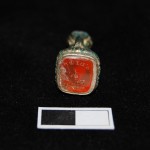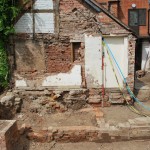On 26 March 2010, a groundbreaking and innovative archaeological project (dubbed Dig for Shakespeare) began in Stratford upon Avon at New Place, the residence of William Shakespeare during his later years, and the place where he died on 23 April 1616.
The site, which is currently a formal garden belonging to the Shakespeare Birthplace Trust (SBT) has, in the past, been the subject of historical research and antiquarian excavations, but has recently received little attention.
Recent pioneering work by Kevin Colls and other members of the Centre of Archaeology at Staffordshire University, aims to re-inform and shed light on Shakespeare and this enigmatic house.
The building of New Place
Around 1483, Sir Hugh Clopton, an important benefactor and later Lord Mayor of Stratford (1491) acquired a burgage plot on the corner of Chapel Street and Chapel Lane, upon which he constructed his house. This house became known as ‘the Newe place’, first named as such in a document of 1532. At the time of its construction, the house was thought to have been the second largest residence in the town (after the college in Old Town), and the only house to have been built using brick as a significant building component.
Around 1540, John Leland, the antiquary, described New Place as a “praty house of bricke and tymbre wherm he (i.e. Hugh Clopton) lived in his latter dayes and dyed”. A Stratford rent roll of 1561 calls New Place ‘domum vocatam the newe place’ (a domus being a mansion house); and the layout and materials used in its construction suggest it was a house of status, designed to be a small manor, befitting of its influential owner. Upon the death of Hugh Clopton in 1496 this ‘grete house in Stratford upon Avon’ was left to his great-nephew William and it proceeded to be retained by the Cloptons until it passed to the Underhill family in 1567.
Becoming the Bard’s home
Shakespeare agreed to the purchase of New Place from William Underhill on 4 May 1597. Shakespeare’s purchase included… ‘one messuage, two barns, and two gardens with appurtenances’. The deed of purchase notes that ‘the same William Shakespeare gave the said William Underhill sixty pounds sterling’, but it is generally agreed that it sold for at least twice that amount.
Shakespeare’s occupancy during this interim period is not entirely clear, however, it would seem that renovations and improvement works began almost immediately, the house having become semi-derelict for a while.
Much of what we know of Shakespeare’s New Place comes from a pen and ink depiction made by George Vertue in 1737. This sketch, accompanied by a site plan and a description, depicts a two storey-with attic, half-timbered building, with five gabled bays and a central ground floor gateway, which faced onto Chapel Street. The house frontage measured about 58 feet (a single burgage plot), and the garden 180 feet long, as documented in local ground rent records. Vertue’s interpretation suggests that this half-timbered and brick structure, was not the actual dwelling house of New Place, but rather formed a gatehouse containing a long gallery and servants quarters. The site plan accompanying this sketch shows this long and thin ‘gatehouse’ running north-south along Chapel Street; this formed the west wing of a courtyard house with a further two east-west running wings and ‘The House’ located to the east.
Using all currently available documentary sources, the Shakespeare Birthplace Trust has reconstructed the site of New Place during the Bard’s ownership. This reconstruction has allowed the Centre of Archaeology to formulate a view of the site and present data for which the archaeological information will be compared.
The beginning of the End: New Place after William Shakespeare
On Shakespeare’s death, like much of his estate, New Place came into the possession of his elder daughter Susanna. Upon her death in 1645, Susanna bequeathed New Place to her daughter, Elizabeth. In 1674 New Place passed back into the ownership of the Cloptons, the family who built the house some two hundred years earlier.
In the mid 18th century, New Place was sold to the Reverend Francis Gastrell. By this time, Stratford had already begun to emerge as a place of Shakespearian pilgrimage. However, Gastrell was quite unappreciative of the house’s association with William Shakespeare and in a fit of rage, attacked and destroyed the mulberry tree in the garden, popularly known to have been planted by Shakespeare himself. In 1759, Gastrell, who lived for part of the year in Lichfield, argued with the rate assessors that he was not liable to pay the full rate to the Stratford parish. On failure of this claim, he vowed that New Place should never be assessed again and razed the house to the ground.
The first antiquarian excavations
Interest in New Place continued unabated and, in 1861, the site was acquired by J.O. Halliwell, an enthusiastic student of Shakespeare’s history, and finally given to the Shakespeare Birthplace Trust. Excavations carried out on the site by Halliwell between 1862 and 1863 succeeded in identifying some elements of both the 15th and 18th-century phases of New Place. The excavations were not backfilled, which resulted in an undulating topography that exists on the site today – and of course, helps us identify the probable areas of in-situ and undisturbed archaeological features and deposits.
Digging for Shakespeare today
During recent work, and current archaeological excavations by the Centre of Archaeology at Staffordshire University, we have learnt more about the layout of Shakespeare’s New Place. Several stone foundations confirm a small frontage range with a service range attached. These buildings enclosed a courtyard, the location of which was identified by large rubbish pits dug in the late 16th century and containing extensive evidence of the personal possessions, status, diet, trade, cottage industries and leisure activities of the occupants of this period.
- Worked bone object – Cribbage peg or textile tool
- Brass fob seal with red glass inset
Important new evidence
The work by the Centre of Archaeology has also provided important evidence that predates Shakespeare. Residual pottery from the Neolithic period (c.4000 to 3500 BC) has already been recovered during excavations. The discovery of grain storage pits also shows that the site was occupied during the Later Iron Age (400-300 BC-AD 43). After a long period of inactivity, it was reoccupied in the 1200-1300s. Much evidence of domestic and industrial activity has been recovered from this period, and perhaps relates directly to the construction of the adjacent Guild Chapel in 1269.










